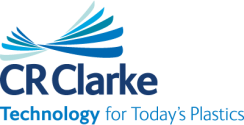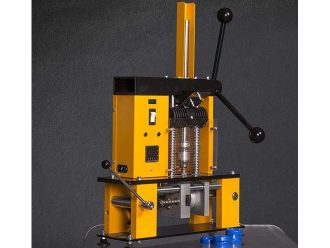Temperature controlled fan circulated ovens, ideal for warming materials for drying, annealing and thermoforming. CR Clarke’s ovens can also reach the higher temperatures required for plastic dip coating.

CR Clarke has been developing and manufacturing their range of high quality equipment for plastic fabrications for over 40 years. AYVA Educational Solutions carries almost all of CR Clarke’s product lines such as Strip Heaters, Vacuum Formers, Edge Polishers and more!
Strip heaters are simple, robust and very easy to operate! CR Clarke’s range of Strip Heaters will suit most applications from simple folds in thin materials to multiple bends in materials up to 25mm thick. All Strip Heaters have been strategically developed for performance, accuracy and ease of use.
The CR Clarke vacuums are forming equipment that is used in many applications including education, industrial fabrication, medical and automotive. All of their vacuum formers are engineered for ease of use, longevity and output quality.
CR Clarke has had over 12 years of experience in developing, manufacturing and optimizing 3D dye transfer systems. With over 500 systems worldwide, they have gained strong knowledge and experience regarding the process, workflow and optimization.
The Thermoform Centre has seven thermoforming processes within one easy-to-use combined machine. As for the Hot Wire Sculptors, they are designed to use and ideal for accurate and clean cuts on expanded polystyrene foam.
Temperature controlled fan circulated ovens, ideal for warming materials for drying, annealing and thermoforming. CR Clarke’s ovens can also reach the higher temperatures required for plastic dip coating.
CR Clarke’s innovative plastic recycling system. Suitable materials (including PMMA, PP, HIPS, LDPE and ABS), are initially granulated, and then re-pressed with heat and pressure to create new sheet materials or completed items.
CR Clarke’s injection moulding machine produces high-quality mouldings from aluminium or steel tools. All working parts of the machine are visible, making this machine ideal in an educational environment.
 Read more
Read more
AYVA carries the fluidized bath which is designed to allow users to dip coat metal items to create a durable and attractive finish.
CR Clarke has supply large-format laser cutting systems from EuroLaser, and also cost-effective fully integrated machines with glass tube lasers.
I have taught grade 9 applied science, science and technology, grade 10 applied, regular and enriched science, grade 11 chemistry and physics for 33 years at Westwood Senior High School in Hudson Québec. I discovered the PASCO equipment in 2019 and it completely changed my life. I love to discover, produce experiments and share discoveries. I am looking forward to work with your team.
Having graduated with a major in Computer Science and minors in Physics and Mathematics, I began my teaching career at Killarney Collegiate Institute in Killarney, Manitoba in 2009. While teaching Physics there, I decided to invest in PASCO products and approached the Killarney Foundation with a proposal about funding the Physics lab with the SPARK Science Learning System and sensors. While there I also started a tremendously successful new course that gave students the ability to explore their interests in science and consisted of students completing one project a month, two of which were to be hands-on experiments, two of which were to be research based, and the final being up to the student.
In 2011 I moved back to Brandon, Manitoba and started working at the school I had graduated from, Crocus Plains Regional Secondary School. In 2018 I finally had the opportunity to once again teach Physics and have been working hard to build the program. Being in the vocational school for the region has led to many opportunities to collaborate with our Electronics, Design Drafting, Welding, and Photography departments on highly engaging inter-disciplinary projects. I believe very strongly in showing students what Physics can look like and build lots of demonstrations and experiments for my classes to use, including a Reuben’s tube, an electromagnetic ring launcher, and Schlieren optics setup, just to name a few that have become fan favourites among the students in our building. At the end of my first year teaching Physics at Crocus Plains I applied for CERN’s International High School Teacher Programme and became the first Canadian selected through direct entry in the 21 years of the program. This incredible opportunity gave me the opportunity to learn from scientists working on the Large Hadron Collider and from CERN’s educational outreach team at the S’Cool Lab. Following this, I returned to Canada and began working with the Perimeter Institute, becoming part of their Teacher Network.
These experiences and being part of professional development workshops with the AAPT and the Canadian Light Source (CLS) this summer has given me the opportunity to speak to many Physics educators around the world to gain new insights into how my classroom evolves. As I work to build our program, I am exploring new ideas that see students take an active role in their learning, more inter-disciplinary work with departments in our school, the development of a STEM For Girls program in our building, and organizing participation in challenges from the ESA, the Students on the Beamline program from CLS, and our local science fair.
Though I graduated with a BEd qualified to teach English and Social Studies, it just wasn’t meant to be. My first job was teaching technology courses at a local high school, a far cry from the English and Social Studies job I had envisioned myself in. I was lucky enough to stay in that position for over ten years, teaching various technology courses in grades 10-12, while also obtaining a Master of Education in Technology Integration and a Master of Education in Online Instructional Media.
You will notice what is absent from my bio is any background in science. In fact, I took the minimum amount of required science courses to graduate high school. Three years ago I switched roles and currently work as a Technology Integration Leader; supporting teachers with integrating technology into their pedagogy in connection with the provincial outcomes. All of our schools have PASCO sensors at some level (mostly grades 4-12) and I made it my professional goal to not only learn how to use them, but to find ways to make them more approachable for teachers with no formal science background (like me!). Having no background or training in science has allowed me to experience a renewed love of Science, making it easier for me to support teachers in learning how to use PASCO sensors in their classrooms. I wholeheartedly believe that if more teachers could see just how easy they are to use, the more they will use them in the classroom and I’ve made it my goal to do exactly that.
I enjoy coming up with out-of-the-box ways of using the sensors, including finding curriculum connections within subjects outside of the typical science realm. I have found that hands on activities with immediate feedback, which PASCO sensors provide, help students and teachers see the benefits of technology in the classroom and will help more students foster a love of science and STEAM learning.